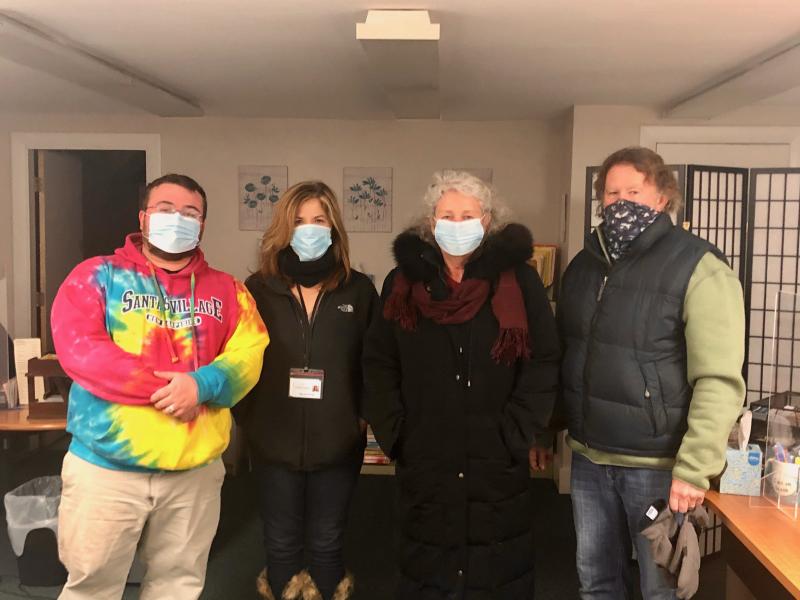Wareham conducts Point-in-Time count of homeless population
While many people cursed Tuesday’s wintry weather, one group of residents viewed the snow that blanketed the town by Wednesday evening as a small stroke of luck.
Snow makes it easier to see footprints, which proves helpful for the volunteers who conduct Wareham’s annual Point-In-Time count of the unsheltered homeless population.
As part of a nationwide effort required by the U.S. Department of Housing and Urban Development, the Point-In-Time count is described as “a count of sheltered and unsheltered people experiencing homelessness” on one night in January. This year, the count occurred on Jan. 27, and six unsheltered individuals were found in Wareham.
“It’s always very convenient when there’s snow on the ground for this night,” said Brandon Reynolds, a housing case manager with Father Bill’s and Mainspring — an organization that works with the homeless and formerly homeless. “So you can see tracks when people are coming in and out on certain paths.”
Tracks in the snow can alert volunteers to encampments that the organizers who work with Wareham’s homeless population aren’t already aware of, Reynolds explained as he prepared for the count.
Along with Reynolds, Peggy Hall, Debbie Ito and Brian Kashner bundled into warm clothes and weather-proof boots Wednesday evening.
It was both Hall and Ito’s first Point-in-Time count. Ito has been the program coordinator at Turning Point — a resource center for the town’s homeless or near-homeless community — for a few months, and she said she felt like she needed to be part of the count.
“To go out there and see, I think is important and gives a whole new perspective to what we do in here,” Ito said.
This year, Wareham’s Point-in-Time count was complicated by the cancelation of the Nights of Hospitality program. For more than a decade, local churches would open their doors to the homeless during the coldest months of the year, providing dinner, a warm place to sleep and breakfast. The program was shut down due to safety concerns about having a large group of individuals gathered indoors amid the ongoing coronavirus pandemic.
For the individuals conducting the Point-in-Time count, that meant the schedule looked a bit different.
“It’s just so much different this year because there’s no Nights of Hospitality,” Reynolds said. He noted that typically, whichever church was hosting the Nights of Hospitality on the night of the count would be volunteers’ first stop.
Instead, in 2021 the volunteers planned to go directly to cars in lots and outdoor encampments in the hopes of determining the accurate number of individuals in town considered unsheltered, per the Department of Housing and Urban Development’s definition.
Generally, this meant volunteers looked to count people living in places that were unfit for human habitation such as cars or tents in the woods, said Hall, who also works at Father Bill’s.
The January Point-in-Time count doesn’t count people living in hotels or couch surfing, as those individuals do not meet the federal definition of homeless. Reynolds said he thought more people had turned to those options this year, after the cancellation Nights of Hospitality.
“I think that really pushed and forced people to really think about what else they could do for options,” Reynolds said. “Into December there were still I would say over 12 to 15 [unsheltered people].”
Reynolds said he expected the final count to be less than 10 people on Jan. 27 — though that could always change once the volunteers were out doing the count.
The count is important, Reynolds explained, because Father Bill’s and Mainspring reports the numbers to the federal government. The numbers reported are used to determine funding for services.
Kashner, who used to be the program coordinator for Turning Point before he retired, said it was hard to explain what the count is truly like.
“[You’re] tromping through the woods — deep in the woods — at 8 o’clock at night,” Kashner said. “Once you get there, it’s just ‘holy smokes, man.’ It’s real stuff. People living in a tent, snow on the ground, 20 degrees outside.”
Reynolds said the local organizations strive to do as much outreach as possible ahead of the count so no one is startled.
“We try to have a rapport with people,” he said.
Hall agreed: “We try to give them a little bit of a head’s up.”
On Thursday, Jan. 28, Reynolds said the count went well. But the team found fewer unsheltered individuals than expected. He said some people who would otherwise have been unsheltered likely found “alternative accommodations” in the short term.
Reynolds said his organization and Turning Point have worked with about 20 people in recent months who are considered borderline homeless because they are couch surfing. But that number is likely far less than the actual number of near-homeless people in Wareham, he said, adding that he has no estimate for the number of families living in hotels because he primarily works with individuals.
Reynolds also said it’s possible that some unsheltered people were missed in the count.
A lot of people were sleeping in their cars, Reynolds said. Additionally, Reynolds explained that the group found one man “who was sleeping without any type of shelter” or any real covering.
“We were looking to use that as a jumping-off point to start to engage with him and continue to try to see if we can work with him going forward,” Reynolds said.
















